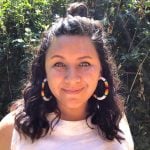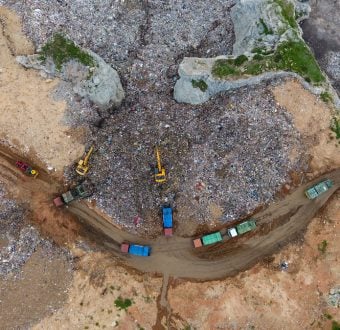Happy Asian American and Pacific Islander (AAPI) Heritage Month! This special month celebrates and pays tribute to the many contributions that generations of AAPI individuals have made to our society and culture.
We want to recognize the drive and power that this community brings to our movement for climate justice. In their own words, here are a few stories and perspectives of AAPI Greenpeacers on the intersections of identity and the climate movement.
Calvin Tran

© Calvin Tran
My name is Calvin and I am Greenpeace USA’s Development Operations Assistant based in Washington, D.C. I am a second-generation Vietnamese-American and a first-generation college graduate in my family. My grandparents emigrated from Guangzhou, China, to Ho Chi Minh City, Vietnam, where my parents were born. My parents later emigrated to the United States, where I was born in Northern Virginia’s suburbs and have lived ever since. I am so proud of my background and upbringing, for it has made my involvement in this climate fight so much more personal and meaningful.
Irene Kim

© Irene Kim
Zero waste living is the latest lifestyle trend for Instagram influencers, but for frugal immigrant households, it’s long been our way of life. My 엄마 and 아빠, immigrants from South Korea, born during the Korean war and raised in difficult times of post-war shortages, cannot bear to be wasteful. We’ve always reused plastic containers, ziploc bags, straws, paper towel sheets, recycled aluminum cans (hello, 5¢ deposit return!), and reduced food waste (overripe kimchi makes better kimchi stew!) Why throw something away when you can reuse it? Why create unnecessary waste?
While their efforts were more an attempt to save money than to save the environment, my parents’ practice of frugality taught me the importance of conservation when I was able to see the benefit to the environment as well. I proudly credit my immigrant parents and their conscientious lifestyle as the foundation for my environmentalist values.
Though the vast majority of climate change has been driven by corporate polluters, everyday people are doing their part to help the environment. I’m inspired by these everyday activists taking action with Greenpeace and being part of the environmental movement. We’re all working together to channel the power of our diverse backgrounds and perspectives and seek a more equitable, just, and free world for all.
Michael Leon Guerrero

© Michael Leon Guerrero
In 1985, Greenpeace made a bold move by sending the Rainbow Warrior to the Micronesian island of Rongelap to relocate the people who were Indigenous to the island. The Rongelapese were returned home 30 years after the military had detonated 66 hydrogen bombs on their homeland. Knowing that the food systems were still severely poisoned by radiation, Greenpeace took direct action and moved the people to another island within the Marshall Island archipelago.
As a fellow Micronesian — Chamorro, the son of the native people of Guam — I was grateful and impressed that Greenpeace had the compassion, audacity, and capacity to execute this feat. Since then, I have had a profound respect for the organization, recognizing its tremendous influence in not only environmental protection but also environmental justice. Greenpeace is an organization that captures peoples’ imagination. It is why so many people bring their talent, creativity, and energy to the organization. Over the past years, I’ve been proud to serve as a member of the Greenpeace Board of Directors.
Kaitlin Grable

© Christian Åslund/Greenpeace
My paternal great grandfather immigrated to California from the Philippines via Hong Kong in the mid-1920s. He became a farmworker in the same fields my maternal grandparents would later labor in after immigrating from Mexico. The communities in which they labored faced major issues of health, safety, and economic injustice — and they still do generations later.
As a multigenerational mixed-race individual (meaning both of my parents, and even some of my grandparents, are mixed race), I’ve faced a lifetime of identity crisis after identity crisis. As I’ve aged into adulthood, I’ve come to realize more and more how the different racial identities within me have shaped me as an activist in this movement. And as I’ve grown in this movement, I’ve come to see how many different issues coincide with the threats facing our lands, waters, and earth. The dangers posed by extractive industries such as mining and oil drilling threaten not just our chances for a livable climate or pristine lands, but also the bodies and lives of Indigenous women and girls. The pesticides we fight against because they decimate bird and pollinator species also poison the people who labor in the crop fields to put food on our tables — people who are predominantly Black and Brown. We can’t have climate justice without racial justice, or without gender justice, or without social justice.
Early on during my time here at Greenpeace, I attended a training where our facilitators taught us a special unity clap. We start together slowly — clap clap clap — the rhythm builds. When it is at a frenzied rate of unsynchronized applause, we pause, hold our hand wide apart and yell, “Isang bagsak!” on the final clap. A phrase in Tagalog that means “one down” or “one fall.” We carry this meaning to remind us that, figuratively, we rise and fall together. This clap was commonly used to unify the Filipinx and Latinx farmworkers who were separated by a language barrier. I feel echoes of my grandfather’s legacy whenever I do it. And I love that all these years later, across movements, we use this as a reminder that we are stronger together. Together is how we will achieve justice. Together is how we get free.
Isang bagsak.





